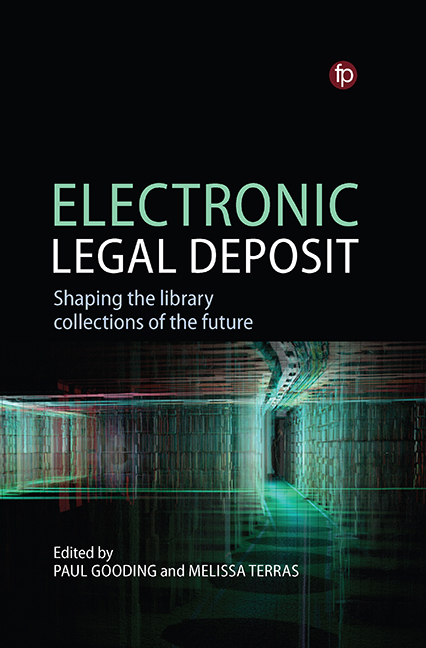Book contents
- Frontmatter
- Dedication
- Contents
- Figures and Tables
- Contributors
- Foreword
- Introduction
- PART 1 INSTITUTIONS AND IMPLEMENTATION
- 1 UK Non-Print Legal Deposit: From Regulations to Review
- 2 The Influence of Legal Deposit Legislation on the Digital Collections of the National Library Of Scotland
- 3 E-legal Deposit at the Biblioteca Nacional de México (National Library of Mexico)
- 4 Bibliographic Control in Zimbabwe: the Conundrum of Legal Deposit in the age of Digital Technologies
- 5 Electronic Legal Deposit in Sweden: the Evolution of Digital Publications and Legislative Systems
- PART 2 USERS AND CONTEXTS
- 6 Publishers, Legal Deposit and the Changing Publishing Environment
- 7 Making History: Digital Preservation and Electronic Legal Deposit in the Second Quarter of the 21st Century
- 8 Giving with one Click, Taking with the Other: Electronic Legal Deposit, Web Archives and Researcher Access
- 9 Follow the Users: Assessing UK non-print Legal Deposit within the Academic Discovery Environment
- 10 ‘An Ark to Save Learning from Deluge’? Reconceptualising Legal Deposit After the Digital Turn
- Index
3 - E-legal Deposit at the Biblioteca Nacional de México (National Library of Mexico)
Published online by Cambridge University Press: 07 November 2020
- Frontmatter
- Dedication
- Contents
- Figures and Tables
- Contributors
- Foreword
- Introduction
- PART 1 INSTITUTIONS AND IMPLEMENTATION
- 1 UK Non-Print Legal Deposit: From Regulations to Review
- 2 The Influence of Legal Deposit Legislation on the Digital Collections of the National Library Of Scotland
- 3 E-legal Deposit at the Biblioteca Nacional de México (National Library of Mexico)
- 4 Bibliographic Control in Zimbabwe: the Conundrum of Legal Deposit in the age of Digital Technologies
- 5 Electronic Legal Deposit in Sweden: the Evolution of Digital Publications and Legislative Systems
- PART 2 USERS AND CONTEXTS
- 6 Publishers, Legal Deposit and the Changing Publishing Environment
- 7 Making History: Digital Preservation and Electronic Legal Deposit in the Second Quarter of the 21st Century
- 8 Giving with one Click, Taking with the Other: Electronic Legal Deposit, Web Archives and Researcher Access
- 9 Follow the Users: Assessing UK non-print Legal Deposit within the Academic Discovery Environment
- 10 ‘An Ark to Save Learning from Deluge’? Reconceptualising Legal Deposit After the Digital Turn
- Index
Summary
The Biblioteca Nacional de México, Mexico's National Library, was founded in 1867. Together with the Biblioteca del Congreso de la Unión, Mexico's Library of Congress, the BNM is the institution responsible for receiving legal deposit in Mexico. The chapter offers a general introduction to the National Library of Mexico and the history of legal deposit in the country in order to frame the current discussion on e-legal deposit. We then go on to discuss three projects that are currently under way at the BNM in which we have participated: a new legislation proposal for legal deposit in Mexico; the development of an e-legal deposit platform between the Universidad Nacional Autónoma de México (UNAM) and the BNM; and the creation of a working group on digital preservation in Mexico. It is within this context, and with these ongoing initiatives, that we explore the current implementation of e-legal deposit within Mexico. Finally, we reflect on how these projects can continue to move forward and future challenges for the BNM.
Introduction
Mexico's national library, the Biblioteca Nacional de México (BNM), was founded in 1867 and opened its doors to the public in 1884. This was a time of political turmoil in Mexico and it was with great difficulty and many setbacks that the library was able to assemble and begin work on cataloguing its collection (Brito Ocampo, 2017). Although from colonial times and during the 19th century there were different ordinances, mandates and decrees that pointed in some way or another to creating collections in order to protect the written heritage of the country, it was not until 1936 that a decree made the lioteca del Congreso de la Unión (BCU) responsible for receiving two copies of books, journals or magazines published in Mexico and in 1957 the BNM was added (Diario Oficial de la Federación, 1991a). In 1944 the Hemeroteca Nacional de México (HNM), the national newspaper library, was created to handle the periodical collection. Although officially these are two institutions, they are closely linked and so for the purpose of this chapter we shall use BNM to refer to both.
The BNM was originally administered directly by the government but in 1929 the decision was taken to give custody of the library to the Universidad Nacional Autónoma de México (UNAM), Mexico's national university.
- Type
- Chapter
- Information
- Electronic Legal DepositShaping the Library Collections of the Future, pp. 57 - 76Publisher: FacetPrint publication year: 2019



